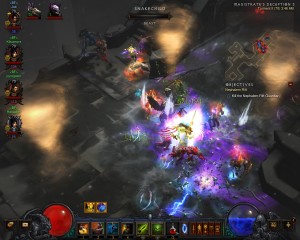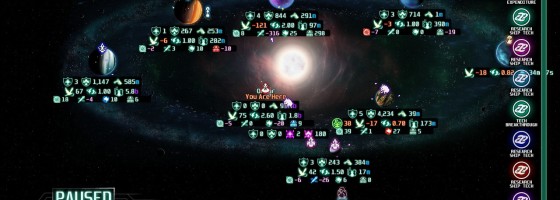In recent posts and discussions on game design, I’ve talked about the importance of establishing a baseline for your content or balance; once you’ve figured it out, this part of your game should remained locked in terms of further balancing. While this concept is important, it’s also one that I don’t think a lot of people actively think about, yet it is vital if you are trying to create an experience that works both in the short and long-term.
Setting the Foundation:
The baseline of a video game can mean different things depending on the game and genre we’re talking about. Generally speaking, the baseline is both the core game mechanic/s and the initial abstracted abilities or stats available to the player.
For example: An action game would define the baseline as the player’s initial move-set, starting health and damage output they can put out. Meanwhile, a RPG would define it as the player’s starting equipment, special abilities or spells, and their ratings in any stats like strength, magic, etc.
In other words, the baseline of a game’s design is the foundation of how the game is played and as we mentioned, it’s critical if you’re trying to create a balanced experience. The reason is that once you have established the exact stats and abilities that the player will have, that will affect the balance of every aspect of your game from then on.
This is especially true for games built around abstracted stats and abilities. One of the tricky parts of balancing game design in abstracted titles is the fact that it’s very hard to know just exactly the player’s abilities or stats are at any given time. In Diablo 3 for instance, with gear procedurally generated, it’s impossible to pinpoint exactly where the player’s power level will be at any given moment. Even then, it’s important to point that Blizzard did establish a baseline for all the gear in the game, along with the ranges of stats for said gear; allowing Blizzard to have some idea of relative power levels.

Baseline design can be applied to any genre, as it’s all about the player’s main way of experiencing your title
The beauty of establishing a baseline is the fact that it tells the game designer that everyone who plays their game will start at X every time, and they can grow things from there.
Knowing where the player starts out can also help you with creating and balancing enemy encounters. If the player starts with five points of health, making the first enemies they run into deal 6 points of damage per hit would be downright unfair.
Even though we’re going to focus on singleplayer titles, multiplayer games can benefit from a baseline as well; Starcraft 2 is such an example. Blizzard is famously known as one of the most meticulous developers when it comes to balancing the stats of their units down to the decimal point to make sure that everything is kept in balance to each other.
Figuring out the baseline for your title goes hand in hand with establishing the core gameplay mechanic, and similar problems can happen if you fail to properly design them.
Back and Forth Production:
A topic that has come up a lot in podcasts with designers is that a great game harmonizes with all of its aspects: Nothing feels out of place or stitched on, everything is like a well oiled machine. Understanding the baseline of your design is a major part of getting that harmony working, and can be a harsh lesson when it doesn’t work out.
Game development is a tricky process; no video game design stays 100% the same from beginning to end. This is why it’s important to figure out your core gameplay and the baseline for your experience as soon as possible, because everything about your game flows from there.
This is why it’s very risky to add in brand new mechanics and across the board changes to your game once you are either mid or late into development. Simply put, if your core gameplay requires a fundamental shift halfway through development, you made a very big mistake somewhere down the line.

Blizzard has gotten smart with Diablo 3: They have left the baseline alone and instead have been focusing on expanding and growing out the content from it
From a baseline point of view, it’s not as damning, but it can cause more work and headaches for the design team. After establishing a baseline for your title, any changes to it will affect everything that connects to it in your game.
This means more time spent in development and balancing, more money spent working on the game and something even worse: If the changes to your game affect the baseline too much, you may have to continue altering things again and again until everything gels right.
Think of it as building a skyscraper: You’re not going to rebuild the first floor while you’re building floors 10 through 20. Every time you have to alter the baseline of your design, all other balancing and design work has to stop, because you are back to working on the fundamental experience of your game.
This is where the practice of iterative design comes into play and the importance of knowing when to set something in stone.
Locking it down:
A phrase that I’ve been using more often these days is “locking your design down,” which means once your baseline or core game mechanic is set and how you like it, you leave it alone. New systems and mechanics should grow from that design, not be a separate addition or feedback into altering the baseline. Being a great game designer not only means coming up with great mechanics and gameplay, but knowing when something just doesn’t fit with the rest of your game and having to cut it.
Understanding the baseline of your experience is an important part of the iterative process; once you’ve gotten it straighten out, it becomes easier to create the rest of the game, because you now have the foundation from which everything should rely on.
On frequent podcasts I’ve had with Chris Park from Arcen Games, we talked about the challenges of creating a multi-system strategy game. His solution was to focus on creating the baseline and main gameplay mechanic first, and then build everything else out from that.

Strategy games in particular rely on a baseline experience, because they are usually built from multiple game systems interacting with each other
Once the basic gameplay is set, it’s easy to pick out if something doesn’t work or to decide what elements to add to the game.
If something has no relation to the baseline and core gameplay, it could be saved for expansion or DLC, whereas content that directly affects your baseline experience can be implemented easier.
There is another discussion regarding the importance of sequels when it comes to iterative design, but we’ll save that for another time.
Hand on the Scales:
The baseline of your game is a very important concept as we’ve talked about, as it infers on everything else in your title. The earlier you establish and set it, the easier it will be to develop your title and the less likely you’ll have to do a complete redesign during development.
More importantly, it will help keep things clear when you’re building a multiple system game to figure out if something truly can fit with the rest of your design.
Game development can be very hard and there are no how-to guides for making the perfect game, just little tips like this that can make the act of developing a game a little easier.


